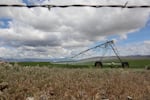
The hay grown in southeastern Oregon's Harney County feeds a global livestock market. But the industry relies on declining groundwater stores.
Emily Cureton Cook / OPB
An Oregon Secretary of State’s Office audit released on Thursday painted a dire picture of the state’s water management system, but its authors frequently stopped short of blaming the agencies in charge of distributing and regulating one of Oregon’s most precious resources.
The audit was subtitled, “State Leadership Must Take Action to Protect Water Security for All Oregonians,” but it fails to mention major industries that have had deleterious effects on the state’s water supplies, including agriculture and developers. The actions suggested by the audit were less direct than the solutions offered by the communities affected by drought, who were more likely to identify the sources of Oregon’s water problems and where the agencies in charge of regulating them were falling short.
“Water is life. And the findings in this advisory report are shocking,” Secretary of State Shemia Fagan said in a statement. “Not only are many families in Oregon dealing with water insecurity today, many more are at high risk of becoming water insecure in the very near future. What’s shocking about this report is it shows that we don’t have a plan to address the problem.”
According to the audit, the problem is being felt all around Oregon.
More than 80% of the state is either in drought or abnormally dry, according to the U.S. Drought Monitor. In some communities in Eastern Oregon, wells have run dry as the area’s groundwater dwindled. The water left has become increasingly toxic, whether it’s trihalomethanes on the North Coast, nitrates in the Lower Umatilla Basin or arsenic in Harney County.
The audit alternates between an encyclopedic history of water management policy in Oregon and personal accounts from people affected by it. Inside and outside the pages of the audit, the everyday people of Oregon were far more direct in urging action against the sources of pollution and depletion than the secretary of state’s office, which listed one of the problems facing the state’s system as “competing interests in water driven by differing values.”
When the audit highlighted the nitrate crisis in rural Morrow and Umatilla counties, the authors noted that the area had not seen meaningful improvement even though the state has been involved for more than 30 years.
In response to the lack of action, auditors concluded that state agencies “need overarching guidance, clear expectations, and support to better engage with communities,” even as they shied away from recommending concrete steps to address the source of nitrates.
During a recent tour and town hall with U.S. Sen. Jeff Merkley, residents pushed for more communication and better representation in the decision-making process. Residents were also unafraid to ask government authorities to hold major nitrate contributors like farms and industrial operations accountable.

A group of rural Boardman residents assemble in a garage to speak with U.S. Sen. Jeff Merkley about nitrates in Boardman, Ore., Jan. 20, 2023.
Antonio Sierra / OPB
When the audit puts the spotlight on Harney County groundwater storage, it mentions a “substantial imbalance between available groundwater and water use by irrigated agriculture.” Meanwhile, people close to the issue point to an Oregon Water Resources Department that is overly deferent to irrigators as a source of the problem, a fact that goes unmentioned in the state audit.
The auditors repeatedly pointed to the state’s decentralized system as a significant roadblock to progress. Eleven state agencies, ranging from the Oregon Department of Environmental Quality to the Oregon Parks and Recreation Department, share the responsibility of managing the state’s water supply. But auditors couldn’t commit to a more centralized management system.
“Having multiple separate agencies responsible for isolated pieces of water management complicates efforts to coordinate across agency lines; however, allowing agencies to focus on their respective pieces of water management may avoid unnecessary delays in the performance of their duties,” the audit states.
The Secretary of State’s Office made several recommendations to the state’s water authorities, including more planning at the state and regional level, better data collection and more communication with affected community members.
Communication and collaboration with Oregon’s American Indian tribes was a way to acknowledge tribal sovereignty and traditional conservation practices, the report’s authors said.
The audit provides spaces for reports from the Confederated Tribes of the Umatilla Indian Reservation and the Klamath Tribes, the latter being involved in a years-long struggle with Southern Oregon farmers over water management. Over the next two years, Klamath River dams will be removed with the support of the tribes, a move that hasn’t come without pushback from outside the reservation.
The tribes said they work closely with state agencies and want to see them staffed at higher levels. But like other communities affected by the state’s water management policy, their concerns are more direct about where problems exist.
According to the Klamath report, the Oregon Department of Agriculture compliance process “can reportedly take years to deliver fines to water abusers,” the state’s cattle grazing rules for riparian areas were “nonsensical” and the state may need to “reconsider water use in the region entirely.”
Meanwhile, the birds and fish that have defined tribal life since time immemorial are quickly disappearing.
“Tribal leadership considers the time for compromise to have passed,” the tribes wrote.
Correction: An earlier version of this story misattributed who is responsible for removing the Klamath dams. A nonprofit, the Klamath River Renewal Corp. is removing the dams with financial support from California and PacifiCorp. OPB regrets the error.

